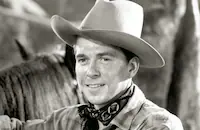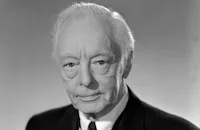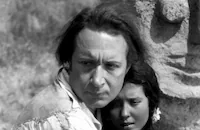Stallion Road

Brief Synopsis
Cast & Crew
James V. Kern
Ronald Reagan
Alexis Smith
Zachary Scott
Peggy Knudson
Patti Brady
Film Details
Technical Specs

Synopsis
Novelist Stephen Purcell visits his friend, Larry Hanrahan, a veterinarian and owner of the Stallion Road ranch in California's Madre Range. He quickly learns that Larry is having an affair with Daisy Otis, wife of banker Ben, who holds the mortgage on the ranch. Shortly after his arrival, Chris, the young sister of horsebreeder Rory Teller, rides through the pouring rain to ask Larry to treat their prize jumping mare, Sultan's Pride, who is very ill. Rory explains that if Sulty wins the coming jumping match, she will be able to sell her for enough money to save her business. Both Steve and Larry are attracted to the beautiful Rory, and later, after the mare recovers, Steve invites her to join him and Larry at the beach, where they have gone to condition Larry's horses. Steve makes a pass at Rory, who turns him down, and when he subsequently sees Rory kiss Larry passionately, he leaves the beach for a local bar. After a fling with Lana Rock, Steve returns to Stallion Road. Rory stops by, and Larry lets her ride Tar Baby, his entry in the competition. Rory is annoyed when she learns that Daisy will be riding Larry's horse in the contest. By the end of the competition, Rory and Daisy are finalists, but Rory's last jump is interrupted when a small child runs in the horse's path. Larry tries to stop her from jumping again and then tries to withdraw Tar Baby, but Rory refuses to win by default and takes her last jump, winning the contest. Several days later, Ben summons Larry to look at his sick cattle, and Larry diagnoses an outbreak of anthrax. Fearing that the disease will spread throughout the valley, Larry works through the night to inoculate the healthy cattle. In the meantime, Sulty again becomes ill, and Rory begs Larry to come, unaware of the epidemic. He refuses, but does not explain why. Rory mistakenly believes that Larry is giving preference to the cattle because he owes Ben money and because he is in love with Daisy, and breaks off their relationship. After Sulty dies, the other horse breeders stop using Larry because of his perceived neglect of Rory's horse. Rory turns to Steve on the rebound, and they become engaged to marry. Larry takes advantage of the extra time on his hands to develop a serum against anthrax. On the eve of her wedding to Steve, Rory calls Larry in desperation because all her horses have become ill. Larry diagnoses anthrax and tries his experimental serum. The disease spreads among the other breeders, but Larry's serum seems to work in most cases. Then, Larry develops anthrax and is on the verge of death. Dr. Stephen is reluctant to use Larry's experimental serum on him, but when Rory learns there is no chance for his recovery, she secretly injects him. After Larry recovers, he and Rory are reconciled, and she agrees to marry him. Steve returns home to write a new novel that he will title Stallion Road .

Director
James V. Kern
Cast

Ronald Reagan

Alexis Smith

Zachary Scott
Peggy Knudson
Patti Brady

Harry Davenport

Angela Greene

Frank Puglia
Ralph Byrd
Lloyd Corrigan
Fernando Alvarado
Matthew Boulton
Mary Gordon
Nina Campana
Dewey Robinson

Paul Panzer
Bobby Valentine
Ralph Littlefield

Tom Wilson
Oscar O'shea
Leon Lenoir

Monte Blue
Fred Kelsey
Elaine Lange
Creighton Hale
Roxanne Stark
Vera Lewis

Douglas Kennedy
Danny Dowling
Joan Winfield
Crew
Milo Anderson
Roy Davidson
Arthur Edeson
Stanley Fleischer
Leo F. Forbstein
Alex Gottlieb
Frederick Hollander
Stanley Jones
James Leicester
Stephen Longstreet
Dick Mayberry
Leonid Raab
Leah Rhodes
Clarence Steensen
Willard Van Enger
Jack L. Warner
David Weisbart
Perc Westmore
Bretaigne Windust

Film Details
Technical Specs

Articles
Stallion Road
Although Reagan the politician (first as Governor of California and then as the 40th President of the United States) would prove staunchly anti-union, the actor nonetheless joined the swelling ranks of the Screen Actor's Guild, (having been recruited by Broderick Crawford's actress mother, Helen Broderick). Reagan served on the SAG board until his career was interrupted by service in World War II. In 1947, he returned to the guild and was elected its president that same year, a position he held for five consecutive terms.
Ronald Reagan had joined the army reserves in 1937, well before the start of World War II. Due to nearsightedness, he was barred from oversees combat and spent the bulk of the war with the Motion Picture Unit of the Army Air Force. Reagan's first film role in postwar Hollywood was the lead in Stallion Road (1947), an adaptation of the novel by Stephen Longstreet. Born in 1907 as Chauncey Weiner, the writer (who employed a number of pseudonyms before settling on "Stephen Longstreet") got his start as a graphic artist while earning extra money writing scripts for NBC Radio. As a novelist (a vocation urged on him by Random House publisher Bennett Cerf, for whom he drew dust jackets), Longstreet made the acquaintance of William Faulkner and the pair wound up heading west to write for the movies. It was Faulkner who got the first crack at adapting Longstreet's 1945 novel Stallion Road (a pass which Longstreet himself championed as "wild, wonderful, mad") but Warners was unhappy with the result and brought Longstreet in to provide a viable shooting script. (Warners had also scotched Faulkner's script for Mildred Pierce (1945), prompting the celebrated but underused novelist to return to his Mississippi home in abject disappointment.)
Warners had planned for Stallion Road to be shot in Technicolor and wanted Humphrey Bogart and Lauren Bacall to star opposite the returning Reagan, cast as a maverick California rancher/veterinarian who finds himself enmeshed in a romantic triangle while facing down an outbreak of bovine anthrax. When the newlyweds opted not to appear in the project (claiming that they were the wrong types for an outdoor picture), the budget was cut in half, the more affordable Zachary Scott and Alexis Smith were slotted into the Bogie and Bacall roles and Technicolor was swapped out for less expensive black and white.
Despite the preproduction compromises, Stallion Road provides a good comeback vehicle for Ronald Reagan and remains charming and cozy entertainment some sixty years after the fact. Even in black and white, the Sierra Madre locations provide a grand canvas for the decidedly soap operatic goings-on and director James V. Kern (fresh from the Errol Flynn comedy Never Say Goodbye, 1946) is aided immeasurably by a strong cast of supporting players, among them Peggy Knudsen (The Big Sleep, 1946) as a banker's wife with an extracurricular eye on Reagan's hunky horse breaker, Frank Puglia (the Casablanca (1942) street vendor with the downwardly sliding price scale) as Reagan's Mexican ranch foreman and Dick Tracy (1937) star Ralph Byrd as a roadhouse proprietor who challenges Reagan to a fistfight. Zachary Scott is amusing as a visiting New York writer out of his element in cowboy country and Alexis Smith is alluring as a long-legged local girl in a tight Concho belt.
Ultimately, Stallion Road belongs to Reagan, who convinces as a resourceful outdoorsman because he was one. Although he missed his SAG comrade Bogart by his side (studio head Jack Warner also nixed Reagan's chance to appear alongside Bogie in John Huston's The Treasure of the Sierra Madre (1948), a role eventually played by Bruce Bennett), Reagan was otherwise delighted with the assignment, which allowed him an entertaining if not stellar return to the limelight and a weekly salary of $3,500 for riding horses. Producer: Alex Gottlieb
Director: James V. Kern
Screenplay: Stephen Longstreet, based on his novel
Cinematography: Arthur Edeson
Art Direction: Stanley Fleischer
Music: Friedrich Hollaender
Film Editing: David Weisbart
Cast: Ronald Reagan (Larry Hanrahan), Alexis Smith (Rory Teller), Zachary Scott (Stephen Purcell), Peggy Knudsen (Daisy Otis), Patti Brady (Chris Teller), Harry Davenport (Dr. Stevens).
BW-98m.
by Richard Harland Smith
Sources:
The Films of Ronald Reagan by Tony Thomas
Bogart by A.M. Sperber and Eric Lax
Introduction to Stallion Road: A Screenplay by William Faulkner by Louis Daniel Brodsky and Robert W. Hamblin
Interview with Stephen Longstreet by Louis Daniel Brodsky

Stallion Road
Ronald Reagan, 1911-2004 - TCM Remembers Ronald Reagan
Ronald Reagan, the actor turned elected official whose fascinating career saw him develop as a contract player for Warner Brothers studios, to a politician who fulfilled his ambitions by becoming the 40th President of the United States, died at his home in Los Angeles on June 5 after a long battle with Alzheimer's disease. He was 93.
He was born Ronald Wilson Reagan on February 6, 1911 in Tampico, Illinois to John and Nelle Reagan. When Reagan was nine, his family settled down in the small community of Dixon, about 100 miles west of Chicago. After high school, Reagan enrolled in Eureka College, a small Christian school near Peoria. He graduated in 1932 with a degree in Economics, and pursued a career in broadcasting. His first gig was as a part-time announcer at WOC in Davenport, Iowa. Within a year, WOC had merged with its big-sister station, WHO in Des Moines, and Reagan was hired as a sports announcer.
In the spring of 1937, Reagan drove to Southern California to catch the Chicago Cubs in spring training on Santa Catalina Island. While he was in California, he wrangled a screen test and signed a contract for $200 a week with Warner Brothers. His film debut was rather inauspicious; he portrayed a radio announcer in an innocuous comedy Love is on the Air (1937). He made a few more "B" programmers like Hollywood Hotel (also 1937), and Girls on Probation (1938), before getting his first prominent role opposite Bette Davis in the popular tearjerker, Dark Victory (1939).
Although he seldom got credit for being a good actor, there was no denying that Reagan held his own given the right material: Knute Rockne, All American as the doomed Notre Dame football hero George "The Gipper" Gipp, where he delivered the film's immortal line "Win one for the Gipper!"; Santa Fe Trail in which he ably supports Errol Flynn in one of the boxoffice hits of its era (both 1940); Kings Row (1941), featuring one of his finest performances as a small-town playboy whose legs are amputated by a careless surgeon; and Desperate Journey (1942) where he again supported Flynn in an exciting action picture.
Due to his poor eyesight, Reagan didn't see any action in World War II, so the studio heads assigned him to star in a series of patriotic films produced by the First Motion Picture Unit of the Army Air Forces in Culver City. Between 1942-45, Reagan starred in over 400 of these films. After the war, Reagan still found some good roles: The Voice of the Turtle (1947) proved he had a deft hand at light comedy opposite Eleanor Parker; The Hasty Heart (1949) offered another underrated performance as he ably portrayed the Yank in John Patrick's much heralded wartime play; and Storm Warning (1950) was a slick melodrama that cast Reagan as a crusading District Attorney determined to bring the KKK in a small southern town, with the help of Doris Day and Ginger Rogers!
It was around this time that Reagan became involved in politics. In 1947, he began a five-year term as president of the Screen Actors Guild (SAG), and testified in October of that year before the newly formed House Un-American Activities Committee (HUAC). He identified suspected Communists Larry Parks, Howard Da Silva and Alexander Knox, all of whom were subsequently called to testify, and subsequently blacklisted. Later records showed Reagan was so concerned about the Communist influence in Hollywood, that he became an FBI informer.
As Reagan became steeped in his political career, his parts throughout the '50s became inferior: the notorious Bedtime for Bonzo (1951); the coy "sex" comedy She's Working Her Way Through College (1952) that cast him as a college professor who romances a stripper! (Virginia Mayo); Cattle Queen of Montana (1955), a sluggish Western that even the redoubtable Barbara Stanwyck couldn't save; and finally Hellcats of the Navy (1957), a stodgy war picture that would be his only film that co-starred his wife Nancy (Davis).
Television offered some salvation. For eight years, (1954-62), Reagan served as the host of General Electric Theater, a televised series of dramas. He also found a niche as GE's goodwill ambassador to employees and to civic and business groups around the country, furthering his taste and honing his craft as a public official. By the mid '60s, Reagan would move into politics entirely, save for one last film, the thrilling The Killers (1964), Reagan's only known villainous role, as a murderous gangster. That same year, he actively campaigned for Republican Presidential candidate Barry Goldwater, although Goldwater lost to Lyndon B. Johnson.
Reagan whose profile was riding high, had cemented his future as a successful politician. In 1966, he ran against incumbent Governor Pat Brown for the state of California and won, serving successfully for two terms until 1974.
Reagan began an all-out, two-year drive to wrest the 1976 nomination from incumbent Gerald R. Ford, an appointed vice president who became president on the resignation of Nixon. Reagan fell short by a handful of delegates to the Republican national convention. But Ford lost to Jimmy Carter, and Reagan became the front-runner to challenge Carter in 1980. After defeating Carter, Reagan held two terms as President of the United States (1981-89). After his second term was over, he retired quietly in California. In 1994, it was revealed to the media that Reagan was suffering from Alzheimer's disease; he had been kept out of the public eye since then.
He was married briefly to actress Jane Wyman (1940-48), and had two children; a daughter Maureen and an adopted son, Michael. In 1952, he married a budding film starlet, Nancy Davis, who bore him two more children; a daughter, Patty; and a son, Ronald Jr. Ronald Reagan is survived by Nancy, Michael, Patty and Ron Jr. His daughter Maureen died of Melanoma in 2001 at the age of 60.
by Michael T. Toole
Ronald Reagan, 1911-2004 - TCM Remembers Ronald Reagan
Quotes
Trivia
Notes
Contemporary sources add the following information about the production: The production, which was to begin in mid-March 1946, was delayed when James Kern became sick after he was assigned to direct, thus delaying the completion of the final script. The film was to star Humphrey Bogart and Lauren Bacall, who were suspended by the studio for refusing the roles. Although one news item reports that Zachary Scott replaced Bogart, Bogart was replaced by star Ronald Reagan. According to a November 8, 1945 press release, Raoul Walsh was to direct the film. Other Hollywood Reporter news items note that Eleanor Parker was considered as a replacement for Bacall. According to a May 1946 press release, Rory Mallinson was assigned to a role, but did not appear in the final film. Some scenes were shot on location in Griffith Park in Los Angeles. The film's credits note that Stallion Road was "produced with the cooperation of the American Humane Association." Modern sources add that William Faulkner wrote a screen version of the Stephen Longstreet novel, which bore little resemblance to the novel and was not used for the film. Ronald Reagan, Alexis Smith and Zachary Scott reprised their roles in a October 4, 1948 Lux Radio Theatre broadcast.

Miscellaneous Notes
Released in United States Spring April 12, 1947
Released in United States Spring April 12, 1947














